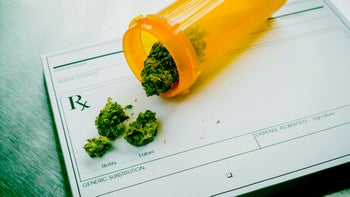
Opioid Withdrawal Symptoms: What Are They And How Long Do They Last?
Key takeaways:
Opioid withdrawal symptoms commonly include sweating, muscle aches, stomach pain, and diarrhea. Many people also experience anxiety and agitation.
How long opioid withdrawal symptoms last depends on what opioid you’ve been taking. But, in general, they start within 24 hours and peak within 2 to 3 days. Most of the time, it takes more than a week for them to fully go away.
Opioid withdrawal symptoms may be uncomfortable, but they’re rarely life-threatening. Medications and other approaches that can help relieve withdrawal symptoms
Table of contents

Opioid medications can be helpful for people experiencing moderate to severe pain. But they have serious risks, such as misuse and overdose, so they’re only prescribed when other pain medications don’t work. Additionally, stopping opioids or switching to a lower dose can lead to opioid withdrawal symptoms.
If you take opioids, it can be helpful to know what opioid withdrawal symptoms look like and how long withdrawal can last.
What is opioid withdrawal?
Opioid withdrawal refers to symptoms that can occur when you stop taking, or reduce the dose, of an opioid. Opioid withdrawal symptoms happen because your body becomes used to having opioids in your system, and relies on them to function normally.
Opioid withdrawal can happen to anyone who stops taking opioids. It’s especially likely if you stop your opioid cold turkey after taking it for more than a few days or weeks. It can also happen if your dose is lowered too quickly. That’s why you should talk to your prescriber before changing your opioid dose or stopping it. They can help you develop a plan to lower your dose over time.
In other cases, experiencing opioid withdrawal is a sign of opioid use disorder (OUD). But along with withdrawal, other symptoms must be present to diagnose OUD. Examples include having cravings for opioids, using opioids despite negative consequences, and using opioids in situations that are dangerous (such as while you’re driving).
What are opioid withdrawal symptoms?
Opioid withdrawal can cause a wide variety of symptoms that affect both the body and the mind.
Opioid side effects: Opioid withdrawal is one possible opioid side effect. But there are many more, including physical dependence, misuse, and overdose.
Non-opioid painkillers: Here’s a list of non-opioid medication options that may be good options for treating long-term chronic pain.
Medication for opioid use disorder (MOUD): Buprenorphine-containing medications and methadone are first-choice medications for OUD. They can also help with opioid withdrawal symptoms.
Physical symptoms may include:
Tearing up more than usual
Blurry vision or trouble focusing
Runny nose
Increased yawning
Shortness of breath
Nausea or vomiting
Stomach cramps
Diarrhea
Increased sweating
Heart palpitations
Goosebumps or hairs standing up on the arms
Shakiness or muscle twitching
Muscle, joint, or bone aches
Mood-related symptoms may include:
Feeling restless, irritable, or anxious
Lack of emotion
Cravings for opioids
Tiredness or trouble sleeping (insomnia)
Emotional pain, including depression
Opioid withdrawal symptom timeline
The timing of opioid withdrawal symptoms depends on the type of opioid you were taking and how much you were taking.
Short-acting opioids typically work quickly and last a shorter amount of time in the body. Long-acting opioids can take longer to start working, but their effects can last for days.
Short-acting opioids also tend to produce quicker and more intense withdrawal symptoms than long-acting opioids. Examples of short-acting opioid medications include immediate-release (IR) morphine, IR oxycodone (Roxicodone), and hydrocodone / acetaminophen. Examples of long-acting opioid medications include extended-release (ER) hydrocodone (Hysingla ER), ER oxycodone (Oxycontin, Xtampza ER), and ER morphine (MS Contin).
In most cases, opioid withdrawal symptoms aren’t life-threatening. But withdrawal is uncomfortable and puts stress on your body. Below, we’ll focus on a typical opioid withdrawal timeline for someone who has opioid use disorder or uses large amounts of opioids. Symptoms often occur in two phases.
Phase One
The first phase of opioid withdrawal is called the acute phase. It occurs right after stopping an opioid and can last several weeks. The chart below covers some general information about the acute phase of opioid withdrawal. It gives you an idea of when opioid withdrawal symptoms first start, peak (feel the most intense), and end.
Short-acting opioids | Long-acting opioids | |
|---|---|---|
Symptoms start | Within 8-12 hours | Within 1-3 days |
Symptoms peak | Around 2-3 days | Around 3-8 days |
Symptoms end | 7-10 days | May last up to to several weeks |
When going through withdrawal, you’ll likely feel physical symptoms first. These can include muscle pain, stomach cramps, and increased sweating. They can also include diarrhea, a runny nose, and yawning. But you may also experience psychological symptoms like agitation, anxiety, and opioid cravings.
After a few days, you may feel like your heart is beating rapidly, and your blood pressure may increase. This might cause you to feel dizzy or give you headaches. You might also have nausea, vomiting, and diarrhea. This can lead to weight loss and loss of appetite.
Phase Two
The second phase of opioid withdrawal lasts longer than the first. How long it lasts varies from person to person, but it can last several weeks or months. In this stage of opioid withdrawal, you may experience more psychological symptoms. These can include long-lasting opioid cravings, depression, anxiety, and loss of motivation. During this phase, the focus of you and your care team is often using medications and therapy to avoid returning to opioid use. We’ll talk more about this later on.
What should you do if you’re experiencing opioid withdrawal?
If you’re experiencing withdrawal symptoms, you may need medical care so you can be monitored by a trained medical staff. And, if necessary, they can get you started on the appropriate medications. For less severe symptoms, you may be able to be seen in an office setting. But for more severe withdrawal, you may need care in a hospital or a dedicated substance use facility.
As mentioned, opioid withdrawal symptoms aren’t usually life-threatening. But for some people — including older adults and those with certain medical conditions — the stress on your body can lead to health complications. For example, spikes in blood pressure may be more dangerous for someone with existing high blood pressure or heart disease.
Below, we’ll cover options for managing opioid withdrawal, and treating OUD itself.
What medications treat opioid withdrawal and OUD?
A number of medications can help ease your withdrawal symptoms and make you more comfortable. There are also medications that treat OUD itself.
Medications for opioid withdrawal symptoms
Several medications can help treat withdrawal symptoms, including:
Acetaminophen (Tylenol) or nonsteroidal anti-inflammatory drugs (NSAIDs), such as ibuprofen (Advil, Motrin), for pain and headaches
Antihistamines, such as cetirizine (Zyrtec) or diphenhydramine (Benadryl) for runny nose and watery eyes
Anti-nausea medications, such as ondansetron (Zofran) or promethazine (Promethegan) for nausea and vomiting
Sleep medications, such as trazodone for trouble sleeping (off-label use)
Anti-diarrheal medications, such as loperamide (Imodium A-D) for diarrhea
Alpha agonists, such as clonidine (Nexlicon-XR, Catapres-TSS) and Lucemyra (lofexidine) for anxiety, chills, and body aches (using clonidine in this way is an off-label use)
Gabapentinoids, such as gabapentin (Neurontin) for mood changes, muscle tension (off-label use)
Medications for OUD
The gold-standard approach for treating OUD is a combination of medications and therapy. This treatment method is called “medications for opioid use disorder (MOUD).” Medications used as part of MOUD include:
Buprenorphine tablets
Buprenorphine / naloxone film (Suboxone) and tablets (Zubsolv)
Methadone liquid, tablets, and dissolvable products (Methadose)
Naltrexone tablets and injection (Vivitrol)
Methadone and buprenorphine-containing medications are first-choice options for OUD. They can also help minimize opioid withdrawal, since they are opioids themselves. But you may have to wait up to a day after your last opioid dose to start Suboxone. Taking it too quickly can actually cause or worsen withdrawal symptoms.
Naltrexone injection may be another treatment option for some people. But it’s not a first-choice medication in most cases. Oral naltrexone isn’t usually recommended as part of MOUD, even though it's FDA approved for this reason.
Medications for OUD can keep you away from opioids, improve quality of life, and minimize your risk of opioid overdose.
What are non-medication options for opioid withdrawal symptoms?
Some steps you can take that may ease your withdrawal symptoms include:
Staying hydrated: Increased sweating and diarrhea can lead to fluid loss. Staying hydrated can help prevent this.
Eating nourishing foods: If you’re having vomiting or diarrhea, consider following a BRAT diet. This bland, starchy diet can help with nausea, vomiting, and diarrhea. Otherwise, focus on foods that give you energy. Examples include fruits, whole grains, and leafy vegetables.
Moving your body: Getting some exercise can help improve withdrawal symptoms like moodiness, insomnia, and pain.
Trying other treatment options, such as acupuncture: Acupuncture is a traditional Chinese treatment approach for various health conditions. It uses hair-thin needles to stimulate sensations at specific spots on the body. For some people, acupuncture provides pain relief. And it may be recommended alongside traditional treatment for OUD or to lessen opioid withdrawal symptoms. Though more research is needed to know how effective acupuncture is in these situations, it’s considered safe for most people. So talk to your healthcare team if you’re interested in trying it.
Where can you get help for OUD?
Your primary care provider is a good person to contact (if you have one). They can discuss treatment options and which medication is best for you. They may be able to prescribe a buprenorphine product for you. Or they can refer you to an addiction specialist who can help.
Additional places you can reach out to for help include:
Your health insurance plan: They can provide a list of covered providers and OUD treatment facilities.
The Substance Abuse and Mental Health Services Administration (SAMHSA): For free and confidential information, anyone can call the SAMHSA helpline at 1-800-662-HELP (4357). It’s available 24/7 every day of the year.
SAMHSA’s online treatment services locator: Find local private and public treatment facilities here by entering your address, city, or zip code. You can also use SAMHSA’s Opioid Treatment Program Directory or their Buprenorphine Treatment Practitioner Locator.
Community-based organizations: Many areas have local support groups to help people and families living with OUD. One international organization that hosts meetings worldwide is called Narcotics Anonymous (NA).
Resources to learn more about OUD are also available from the National Harm Reduction Coalition and the CDC.
The bottom line
Opioid withdrawal symptoms can occur when you stop taking an opioid or reduce your dose. It can happen to anyone taking opioids. But it can also be a sign of opioid use disorder (OUD) if other signs are present as well. How long opioid withdrawal symptoms last depends on what opioid you were taking. It also depends on how long you took it for and other individual factors.
While opioid withdrawal symptoms can be uncomfortable, they’re usually not life-threatening. A healthcare professional may recommend medications to treat symptoms. Examples include pain medications like acetaminophen (Tylenol) or ibuprofen (Advil, Motrin). Anti-nausea medications like ondansetron (Zofran), and antidiarrheals like loperamide (Imodium-AD) may also help. A healthcare professional may also prescribe clonidine (Nexlicon-XR, Catapres-TSS) or gabapentin (Neurontin) for other withdrawal symptoms, such as anxiety, chills, and muscle tension.
If you experience opioid withdrawal symptoms, reach out to your healthcare team. They can help you decide if treatment is needed.
Why trust our experts?



References
American Society of Addiction Medicine. (2020). The ASAM national practice guideline for the treatment of opioid use disorder: 2020 focused update.
Argoff, C. E., et al. (2009). A comparison of long and short-acting opioids for the treatment of chronic noncancer pain: Tailoring therapy to meet patient needs. Mayo Clinic Proceedings.
Grant, S., et al. (2016). Acupuncture for substance use disorders: A systematic review and meta-analysis. Drug and Alcohol Dependence.
Gripshover, J., et al. (2022). Managing opioid withdrawal in an outpatient setting with lofexidine or clonidine. Cureus.
Pergolizzi, J. V., Jr., et al. (2020). Opioid withdrawal symptoms, a consequence of chronic opioid use and opioid use disorder: Current understanding and approaches to management. Journal of Clinical Pharmacy and Therapeutics.
Salehi, M., et al. (2011). Importance of gabapentin dose in treatment of opioid withdrawal. Journal of Clinical Psychopharmacology.
Sommers, E., et al. (2021). Pain and opioid use: Evidence for integrating acupuncture into treatment planning. Global Advances in Health and Medicine.
Substance Abuse and Mental Health Services Administration. (2021). Medications for opioid use disorder.
World Health Organization. (2009). Withdrawal management. Clinical Guidelines for Withdrawal Management and Treatment of Drug Dependence in Closed Settings. WHO Press.
If you or someone you know struggles with substance use, help is available. Call SAMHSA’s National Helpline at 1-800-662-4357 to learn about resources in your area.
























